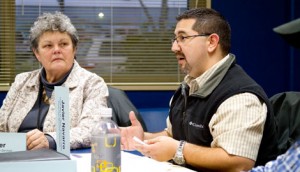The finer details of what Bus Rapid Transit (BRT) might look like on Fourth Plain Boulevard have come into sharper focus in recent weeks – and with it have come questions from citizens about safety and the impact of a BRT line on the economic vitality of the Fourth Plain corridor.

Andersen Glass owner Bill Steiner and consultant Stefano Viggiano examine a map of proposed Bus Rapid Transit.
C-Tran has plans to construct a $78 million BRT line on a 4.5-mile stretch of Fourth Plain between the Westfield Mall and Clark College. A less expensive sibling to light rail, BRT features articulated buses, pre-boarding fare payment, and bus stations that allow for level boarding.
C-Tran will need $62.4 million in federal funds and a $15.6 million loan to fund capital costs. It will also require passage of a 0.1 sales tax increase next year to raise the $3 million needed to operate the BRT system, along with the light rail line that is scheduled as part of the Columbia River Crossing Light Rail project.
Last month, the C-Tran board of directors approved three alternative BRT configurations for Fourth Plain, and two additional alternatives for a short stretch of Fort Vancouver Way near Clark College.
The Fourth Plain alternatives include buses in mixed traffic with curbside stations, buses in mixed traffic with stations in the median, and buses in a semi-exclusive business access and transit (BAT) lane with curbside stations. For Fort Vancouver Way, the board also approved both a single and a double center bus-only lane with a station in the middle of the street.
Design workshops flesh out details and citizen concerns
To further drill down to the details, C-Tran hosted two public design workshops, Nov. 16 and 19, during which 30 citizens made suggestions regarding bus stop locations and station architecture with the help of a three-dimensional computer.

Fourth Plain business owner Javier Navarro comments about the need for improved safety measures in the corridor as committee member Pat Stryker looks on.
The maps showed the recommended placements of both curbside and median stations along Fourth Plain. The BRT line would eliminate the #4 and #44 local bus routes and reduce the existing 19 bus stops in the corridor to 14 stations.
The average distance between stations would range from one quarter to one third of a mile, although stations east of Andresen could be spread out as far as a half a mile.
That news left some committee members with concerns over safety and the increased distances riders may have to walk.
Committee member Dimitry Mishchuk, who lives in eastern Vancouver, said people in his neighborhood don’t use the bus because they don’t feel it’s convenient. Increasing the space between bus stations will further discourage them. Ironically, he said, East Vancouver is poised for development and C-Tran could lose a lot of future riders that might otherwise be interested.
“There are a lot of low-income families,” Mishchuk said. “I believe that area is really going to grow. That’s where the development is going to be in 20 years.”
Insurance agent Javier Navarro echoed conversations he’s had with fellow business owners about the broader streetscape improvements that would be necessary to make Fourth Plain a safer and more attractive place for people to seek out.
The City of Vancouver’s Fourth Plain Subarea Plan envisions pedestrian and transit friendly streetscapes, but the city hasn’t had the funding to implement it. Navarro wondered if the BRT line would create a problem if the larger street improvements weren’t addressed.
“Why isn’t safety a concern and why isn’t lighting the entire street [with] better lighting a higher priority as part of the project?” Navarro asked.
According to project consultant Stefano Viggiano, of Portland firm Parsons Brinkerhoff, the Federal Transit Authority has been known to allow BRT construction to include broader enhancements beyond the stations themselves.
“Improving the lighting in a sort of wide station area is typically accepted as part of a project,” Viggiano said.
Another community member, Judy Tiffany, commented that placing too many stations in the median could disrupt the common – although frowned upon – practice of trucks parking temporarily in the median to make deliveries.
“It could get overlooked,” she said. “I see trucks in that median delivering goods all the time.”
Per federal guidelines, Viggiano also covered a transit improvement plan that could address C-Tran’s goals for enhancing the Fourth Plain corridor without BRT – or the federal funds that would come with it.
The meeting adjourned without any new decision. The five BRT alternatives, plus the transit improvement and “no build” scenarios, will continue in the pipeline for further review by the public and the C-Tran board, which will ultimately select a preferred alternative early next year.
______________________________________________________________________________________
See our continuing coverage of the Columbia River Crossing Light Rail project.
Do you have information to share on the CRC? To respond anonymously call 260-816-1426. To allow your comments to be used on COUV.COM call 260-816-1429.









